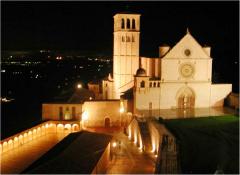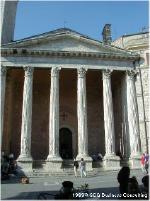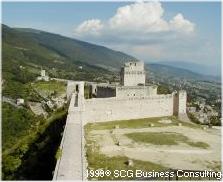Assisi -
Monuments in the Old Town Centre
 |
| Basilica di San Francesco |
A perfectly preserved Roman temple, once to the goddess Minerva, stands in the city's main square, but the main attraction of Assisi remains without a doubt the Basilica of St Francis both on account of its extraordinary artistic treasures and its world importance as a religious centre.
These are the main sights to see in Assisi:
 |
| Tempio di Minerva |
Built in the late Republican period in the 1st century BC, this temple was erected by the quatorvirates Gneus Cesius and Titus Cesius Priscus at their own expense. When a female statue was unearthed here it was thought the temple had been dedicated to Minerva, although the subsequent discovery of a votive plaque to Hercules makes it more likely that the temple had been dedicated to him. The facade has survived surprisingly well, with its six fluted columns supporting corinthian capitals and standing on plinths that rest on the steps leading to the pronaos for lack of space. In 1539 the inner sanctum of the temple was transformed into the church of Santa Maria Sopra Minerva, with further alterations added in the Baroque style during the 17th century.
Palazzo del Capitano del Popolo
Built between 1212 and 1305, this was the first public building to be erected in Piazza del Comune. The facade of the building contains the measures for silk, linen and wool, as well as the outlines of bricks and roof tiles used in building. The first fresco in the cycle of the life of St Francis shows the Palazzo del Capitano del Popolo without the upper part of its tower, which was not added until 1305. Restoration work carried out in 1927 considerably altered the original appearance of the building.
Church of Santa Maria Maggiore
Founded in the 10th century, the church was the cathedral of Assisi before 1036, when the church of San Rufino took over the position. The building we see today dates back to the 12th century. The simple facade bears an inscription from 1163 and is divided into three sections by pilaster strips.
The nave, semi-circular apse and sacristy still have remains of frescoes from the 14th and 15th century. A late-Medieval 9th century sarcophagus lies to the right of the entrance. The crypt dates back to the previous church and leads via a passageway to the so-called House of Propertius, with its Pompeian style wall paintings. Remains of the old Roman city walls are visible from the adjacent gardens. Built out of limestone from Mount Subasio, the Roman blocks have been used as a base for the later Medieval fortifications. Although Santa Maria Maggiore had lost its status of cathedral, the nearby bishop's palace where St Francis renounced his earthly wealth continued to be used as such.
 |
| Rocca Maggiore |
The earlies records of this building date back to 1174, when it was erected as a German feudal castle. The future Emperor Frederick II of Swabia spent several years of his childhood here in the care of Conrad of Urslingen, and was baptised in Assisi at the age of three in 1197. The following year, in Conrad's absence, the people of Assisi rebelled and destroyed the castle. The castle remained a ruin until 1367, when Cardinal Albornoz rebuilt the fortress using the western section of outside walls and part of the interior fortifications.
In 1458 Jacopo Piccinino, then lord of Assisi, erected the twelve-sided tower and the long curtain wall connecting the castle to the city. In 1478 Pope Sixtus IV restored the castle's keep, while between 1535 and 1538 Pope Paul III built the round tower near the main gate.
© Copyright 2001-2025
by Umbriaonline.com
SCG Business Consulting S.a.s. di Giacomelli E. & C. - Internet Advertising Division - © 2001-2025 All Rights Reserved - P.IVA 01675690562